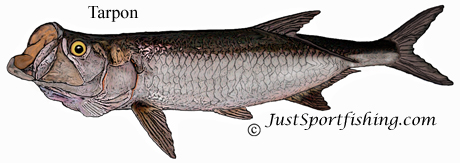|
|

How
to fish for Tarpon
The Tarpon is considered one of the great saltwater game fish not only because of the size it can reach and its accessible habitat, but because of its fighting spirit when hooked. The Tarpon is very strong and when hooked it makes spectacular leaps into the air. Most Tarpon caught by anglers are 40 to 50 pounds but Tarpon up to 100 pounds are not uncommon. Tarpon are most abundant in the months of May through July, but they are caught in all months. Tarpon range from Virginia to central Brazil in the western Atlantic, along the coast of Africa in the eastern Atlantic, and all through the Gulf of Mexico and Caribbean Sea.
Tarpon will take a variety of live and dead bait, as well as artificial lures and flies. Tarpon are caught in estuaries, lagoons, tidal flats, mangrove swamps, and around structures such as piers and bridges.
When fishing for Tarpon with live bait use crabs, shrimp, pinfish and mullet. The basic live bait technique is to anchor a boat and free line a lively bait down current to areas that are known to hold tarpon. Sometimes the bait is weighted to get it near the bottom.
Tarpon have hard mouths and hooks need to be properly sharpened to ensure a hook up. For tarpon fishing leaders should be about 6 to 12 feet of heavy monofilament or fluorocarbon line from 60 to 125 LB test. Tarpon fishing hooks will vary with the size of the bait and hook brand. A 6/0 live bait hook to an 11/0 circle hook works best. It's important to rig the live baits in the most natural way possible. For Tarpon fishing with live bait you should hook a crab in the corner of the shell, pinfish and mullet are hooked through the mouth either vertically or horizontally. When you are fishing with shrimp a good trick is to head or tail hook the shrimp on a hook up jig so it won't spin in the current.
When fishing around bridges or piers 20 LB spinning gear or 30 LB conventional gear is required. For open water tarpon fishing and smaller tarpon you could drop down to 12 or 15 LB light tackle depending on the size of the Tarpon in the area. A medium to heavy 7 foot rod is a good choice depending again on the size of Tarpon in the area.
A Tarpons body and gill plates are abrasive and can damage line in hurry. A light leader set up for Tarpon fishing would be 3 feet of 60 LB fluorocarbon leader tied to 10 feet of 40 LB leader attached to 15 or 20 LB doubled main line. For bridge or pier Tarpon fishing try 6 to 10 feet of 100 to 125 LB leader tied to a heavy barrel swivel or directly to a doubled 20 or 30 LB main line.
If you are tarpon fishing with 20 pound test line set the drag at 4 to 5 pounds. A good way to be sure of the drag setting is to use a hand held scale to double check your setting. Because the size of Tarpon varies greatly by area pick your line test accordingly. Tarpon are strong fighters and having your drag set accordingly is important. Just remember with Tarpon you need to tire the fish, you cant strong arm a Tarpon to the boat or you will break your line.

|
JustSportfishing.com

|


